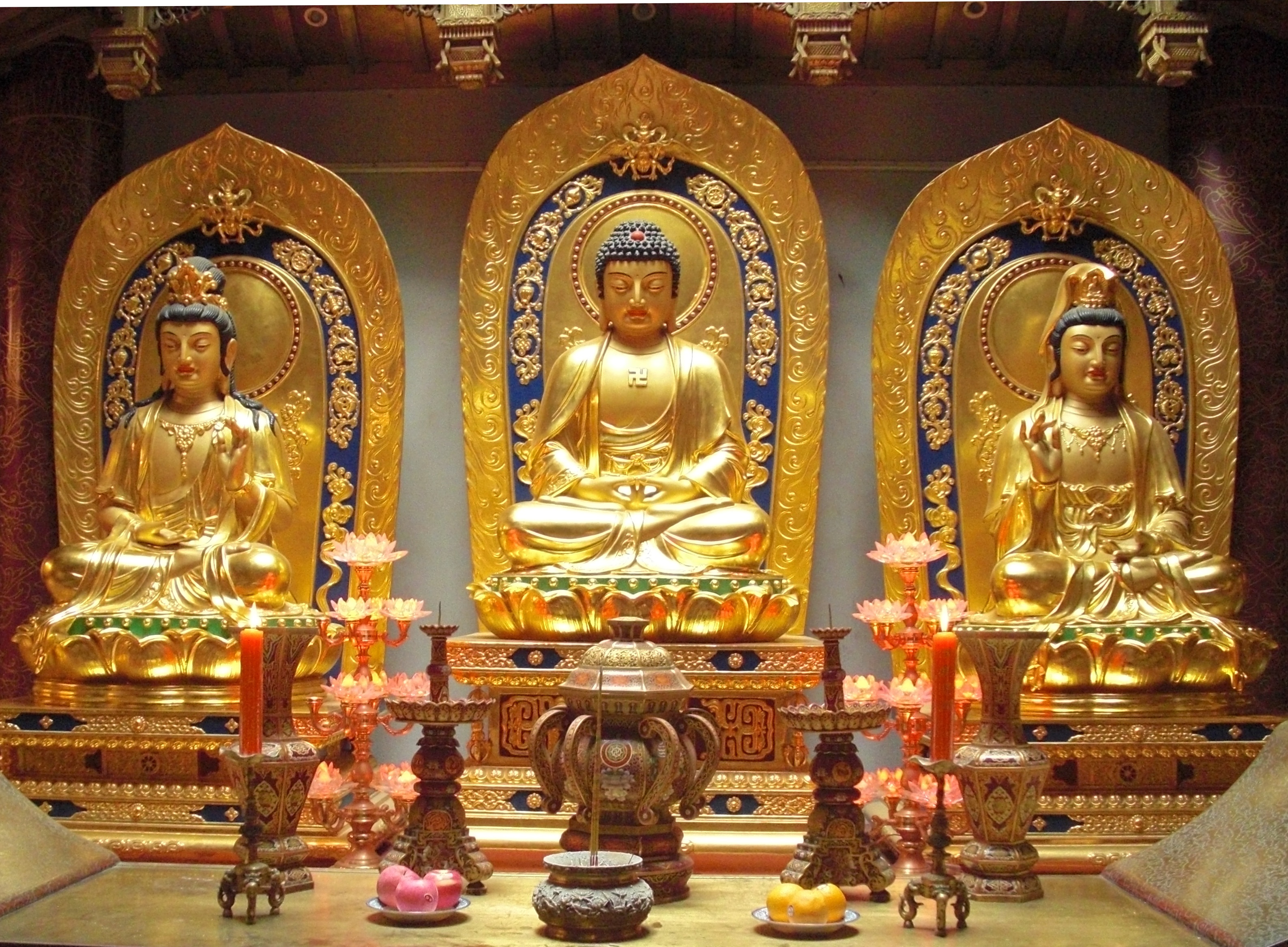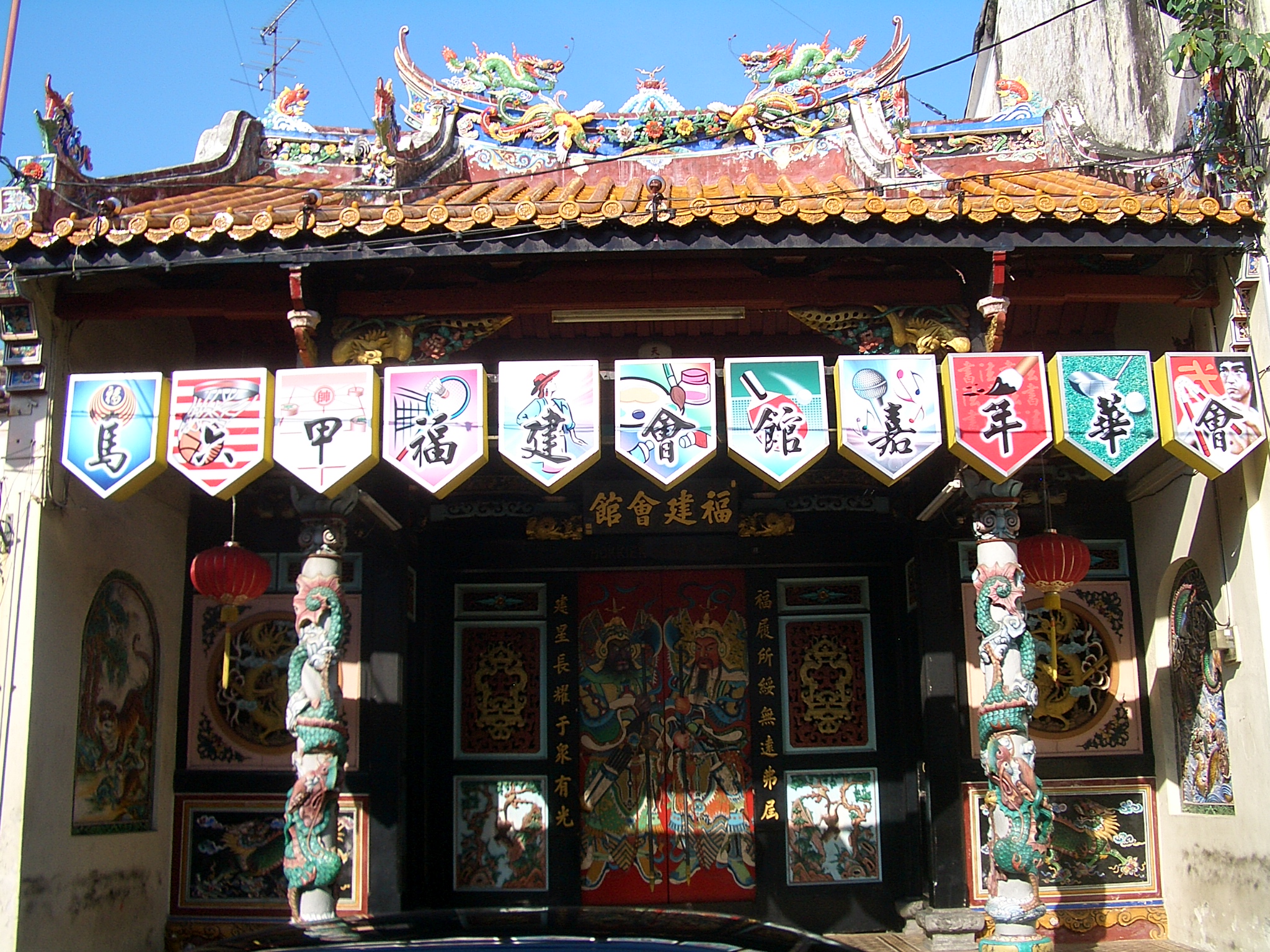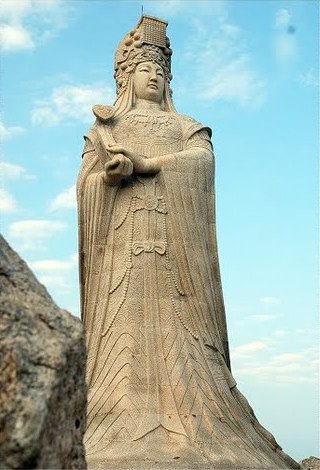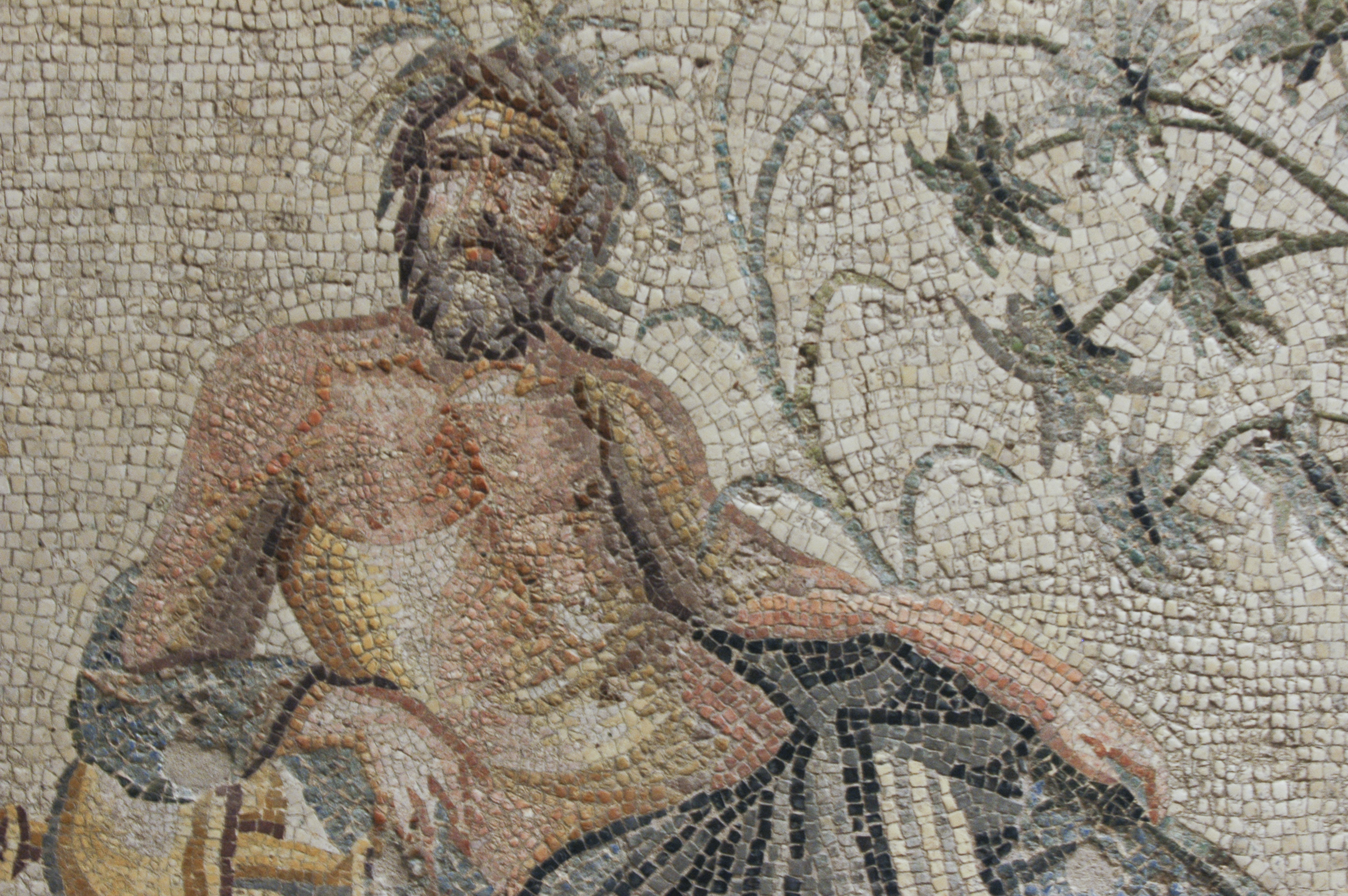|
Quan Am Temple
Quan Am Temple is a Chinese-style Buddhist temple located on Lao Tu Street in Cho Lon, District 5, Ho Chi Minh City, Vietnam. Founded in the 19th century, it is dedicated to Guanyin (), the Chinese goddess of mercy and the Chinese form of the Indian bodhisattva Avalokiteshvara. The pagoda is popular among both Vietnamese and Chinese Buddhists; most of its inscriptions are in Chinese characters, but some have had Vietnamese labels added. In addition to veneration of Guanyin and the teachings of the Buddha, the pagoda also includes Pure Land worship of the Amitabha Buddha ('), elements of Taoism, and the folk worship of the Fujianese sea goddess Mazu in her role as the "Queen of Heaven" ('). History The temple was built by Hokkien immigrants to the city in the late 19th century. Layout On one side of Lao Tu Street is the pagoda complex, with an entrance through a gatehouse; on the other side is an associated garden with an artificial pond. The pagoda complex itself con ... [...More Info...] [...Related Items...] OR: [Wikipedia] [Google] [Baidu] |
Vietnam
Vietnam, officially the Socialist Republic of Vietnam (SRV), is a country at the eastern edge of mainland Southeast Asia, with an area of about and a population of over 100 million, making it the world's List of countries and dependencies by population, fifteenth-most populous country. One of two communist states in Southeast Asia, Vietnam shares land borders with China to the north, and Laos and Cambodia to the west. It shares Maritime boundary, maritime borders with Thailand through the Gulf of Thailand, and the Philippines, Indonesia, and Malaysia through the South China Sea. Its capital is Hanoi and its largest city is Ho Chi Minh City. Vietnam was inhabited by the Paleolithic age, with states established in the first millennium BC on the Red River Delta in modern-day northern Vietnam. Before the Han dynasty's invasion, Vietnam was marked by a vibrant mix of religion, culture, and social norms. The Han dynasty annexed Northern and Central Vietnam, which were subs ... [...More Info...] [...Related Items...] OR: [Wikipedia] [Google] [Baidu] |
Pure Land Buddhism
Pure Land Buddhism or the Pure Land School ( zh, c=淨土宗, p=Jìngtǔzōng) is a broad branch of Mahayana, Mahayana Buddhism focused on achieving rebirth in a Pure land, Pure Land. It is one of the most widely practiced traditions of East Asian Buddhism, Buddhism in East Asia. It is also known as the "Lotus School" (Chinese language, Chinese: 蓮宗; pinyin: ''Liánzōng'') in China or the "Nianfo, Nembutsu school" in Japan. East Asian Pure Land mainly relies on three main Mahayana sutras, Mahayana scriptures: the ''Longer Sukhāvatīvyūha Sūtra, Sutra of Amitayus'', the ''Amitāyus Contemplation Sūtra, Contemplation Sutra'' and the ''Shorter Sukhāvatīvyūha Sūtra, Amitabha Sutra''. The Pure Land tradition is primarily focused on achieving rebirth in a Buddhahood, Buddha's "pure land", a superior place to spiritually train for full Buddhahood, where one can meet a Buddha face to face and study under them without any of the distractions or fears of our world.Williams, Pau ... [...More Info...] [...Related Items...] OR: [Wikipedia] [Google] [Baidu] |
Chinese Dragon
The Chinese dragon or loong is a legendary creature in Chinese mythology, Chinese folklore, and Chinese culture generally. Chinese dragons have many animal-like forms, such as Bixi (mythology), turtles and Chiwen, fish, but are most commonly depicted as snake-like with four legs. Academicians have identified four reliable theories on the origin of the Chinese dragon: Snakes in Chinese mythology, snakes, Chinese alligators, thunder worship and nature worship. They traditionally symbolize potent and auspicious powers, particularly control over water and weather. Symbolism Historically, the Chinese dragon was associated with the emperor of China and used as a symbol to represent imperial power. Liu Bang, the founder of the Han dynasty, claimed that he was conceived after his mother dreamt of a dragon. During the Tang dynasty, emperors wore robes with dragon motif as an imperial symbol, and high officials might also be presented with dragon robes. In the Yuan dynasty, the ... [...More Info...] [...Related Items...] OR: [Wikipedia] [Google] [Baidu] |
Quan Âm Pagoda - Panels In Garden
Quán is the Pinyin romanization of the Chinese family names / and , as well as a customary spelling of (pinyin: Guān). All written forms of the name are rare enough that they do not appear in the list of the 100 most common Chinese surnames. 權 Quan () is a Chinese surname. A notable with the surname Quan surname was Quan Deyu, who was born in 759 during the reign of Emperor Suzong. His family claimed to descend from the Later Qin official Quan Yi (權翼). His family tree was from the Sui dynasty official Quan Rong (權榮). During the Shang dynasty, the Quan family founded the state of Quan (權國). In the state of Chu, the Xiong family lived in Quan County (權縣), and took the surname Quan. 全 Quan (), is a Chinese family name. Liang and Yang in alternative Mandarin are other spellings. The character 全 is rendered as Jeon in Korean and is one of several Chinese characters for the common Korean surname Jeon (Chun). The character 全 is rendered as To� ... [...More Info...] [...Related Items...] OR: [Wikipedia] [Google] [Baidu] |
Taoist
Taoism or Daoism (, ) is a diverse philosophical and religious tradition indigenous to China, emphasizing harmony with the Tao ( zh, p=dào, w=tao4). With a range of meaning in Chinese philosophy, translations of Tao include 'way', 'road', 'path', or 'technique', generally understood in the Taoist sense as an enigmatic process of transformation ultimately underlying reality. Taoist thought has informed the development of various practices within the Taoist tradition and beyond, including forms of meditation, astrology, qigong, feng shui, and internal alchemy. A common goal of Taoist practice is self-cultivation, a deeper appreciation of the Tao, and more harmonious existence. Taoist ethics vary, but generally emphasize such virtues as '' effortless action'', ''naturalness'', ''simplicity'', and the three treasures of compassion, frugality, and humility. The core of Taoist thought crystallized during the early Warring States period (), during which the epigrammatic an ... [...More Info...] [...Related Items...] OR: [Wikipedia] [Google] [Baidu] |
Amrita
''Amrita'' (, IAST: ''amṛta''), ''Amrit'' or ''Amata'' in Pali language, Pali, (also called ''Sudha'', ''Amiy'', ''Ami'') is a Sanskrit word that means "immortality". It is a central concept within Indian religions and is often referred to in ancient Indian texts as an Elixir of life, elixir. Its first occurrence is in the Rigveda, where it is considered one of several synonyms for ''soma (drink), soma'', the drink of the Deva (Hinduism), devas. Amrita plays a significant role in the Samudra manthan, Samudra Manthana, and is the cause of the conflict between devas and asuras competing for amrita to obtain immortality. Amrita has varying significance in different Indian religions. The word ''Amrit'' is also a common first name for Sikhs and Hindus, while its feminine form is ''Amritā''. Amrita is cognate to and shares many similarities with ambrosia; both originated from a common Proto-Indo-European mythology, Proto-Indo-European source."Ambrosia" in ''Chambers's Encyclopædi ... [...More Info...] [...Related Items...] OR: [Wikipedia] [Google] [Baidu] |
Lotus (plant)
Lotus identifies various plant taxa: * ''Nelumbo'', a genus of aquatic plants with showy flowers known as lotuses, having two extant species: ** ''Nelumbo nucifera'', the Sacred or Indian lotus ** ''Nelumbo lutea'', the American or yellow lotus * Certain species of ''Nymphaea'', a genus of aquatic plants known as water lilies, are also known as Egyptian lotus or Egyptian water lily: ** ''Nymphaea caerulea'', also known as blue lotus ** '' Nymphaea lotus'', white lotus or sacred lotus ** '' Nymphaea nouchali'', also known as blue or star lotus (sometimes thought to be the same species as ''Nymphaea caerulea'' above) * '' Lotus'', a terrestrial genus of legumes with small flowers, including bird's-foot trefoils and deervetches * Certain species of '' Saussurea'', a genus of herbaceous plant, are known as snow lotus, particularly those from the Himalayan vicinity * ''Ziziphus lotus'', a shrub species with edible fruit * ''Diospyros lotus'', a tree with edible fruit known as the date-p ... [...More Info...] [...Related Items...] OR: [Wikipedia] [Google] [Baidu] |
Chinese Art
Chinese art is visual art that originated in or is practiced in China, Greater China or by Chinese artists. Art created by Chinese residing outside of China can also be considered a part of Chinese art when it is based on or draws on Chinese culture, heritage, and history. Early "Stone Age art" dates back to 10,000 BC, mostly consisting of simple pottery and sculptures. After that period, Chinese art, like Chinese history, was typically classified by the succession of ruling dynasties of Chinese emperors, most of which lasted several hundred years. The Palace Museum in Beijing and the National Palace Museum in Taipei contains extensive collections of Chinese art. Chinese art is marked by an unusual degree of continuity within, and consciousness of, tradition, lacking an equivalent to the Western collapse and gradual recovery of Western classical styles of art. Decorative arts are extremely important in Chinese art, and much of the finest work was produced in large wor ... [...More Info...] [...Related Items...] OR: [Wikipedia] [Google] [Baidu] |
Jade Emperor
In the Chinese mythology, myths and Chinese folk religion, folk religion of Chinese culture, the Jade Emperor or Yudi is one of the representations of the Primordial Divinity (Tai Di), primordial god. In Taoist theology, he is the assistant of Yuanshi Tianzun, who is one of the Three Pure Ones, the three primordial emanations of the Tao. However, some Taoists in history were skeptical of his benevolence because his buildings and infrastructure in heaven and earth were sometimes seen as interfering with the many natural laws or Tao, dao. He is often identified with Śakra (Buddhism), Śakra in Chinese Buddhist cosmology and identified with Yu the Great in Chinese mythology. The Jade Emperor is known by many names, including Yu, Heavenly Grandfather (, '), which originally meant "Heavenly Duke", which is used by commoners; the Jade Lord; the Highest Emperor; Great Emperor of Jade ( , or ). Chinese mythology There are many stories in Chinese mythology involving the Jade Empe ... [...More Info...] [...Related Items...] OR: [Wikipedia] [Google] [Baidu] |
Hoklo People
The Hoklo people () are a Han Chinese subgroup who speak Hokkien, a Southern Min language, or trace their ancestry to southeastern Fujian in China, and known by various related terms such as Banlam people (), Minnan people, Fujianese people or more commonly in Southeast Asia as the Hokkien people (). The Hokkien people are found in significant numbers in China, Taiwan, Hong Kong, Macau, Singapore, Malaysia, Philippines, Indonesia, Brunei, Myanmar, and the United States. The Hokkien people have a distinct culture and architecture, including Hokkien shrines and temples with tilted sharp eaves, high and slanted top roofs, and finely detailed decorative inlays of wood and porcelain. The Hokkien language, which includes Taiwanese Hokkien, is the mainstream Southern Min, which is partially mutually intelligible to other Southern Min varieties such as Teochew, Zhongshan, Haklau, and Zhenan. Etymology In Southern Fujian, the Hokkien speakers refer to themselves as Banlam peopl ... [...More Info...] [...Related Items...] OR: [Wikipedia] [Google] [Baidu] |
Mazu (goddess)
Mazu or Matsu is a sea goddess in Chinese folk religion, Chinese Buddhism, Confucianism, and Taoism. She is also known by several other names and titles. Mazu is the deified form of Lin Moniang (), a shamaness from Fujian who is said to have lived in the late 10th century. After her death, she became revered as a tutelary deity of Chinese seafarers, including fishermen and sailors. Her worship spread throughout China's coastal regions and overseas Chinese communities throughout Southeast Asia, where some Mazuist temples are affiliated with famous Taiwanese temples. Mazu was traditionally thought to roam the seas, protecting her believers through miraculous interventions. She is now generally regarded by her believers as a powerful and benevolent Queen of Heaven. Mazu worship is popular in Taiwan because many early Chinese settlers in Taiwan were Hoklo people from Fujian. Her temple festival is a major event in Taiwan, with the largest celebrations occurring in and a ... [...More Info...] [...Related Items...] OR: [Wikipedia] [Google] [Baidu] |
Sea Goddess
A water deity is a deity in mythology associated with water or various bodies of water. Water deities are common in mythology and were usually more important among civilizations in which the sea or ocean, or a great river was more important. Another important focus of worship of water deities has been springs or holy wells. As a form of animal worship, whales and snakes (hence dragons) have been regarded as godly deities throughout the world (as are other animals such as turtles, fish, crabs, and sharks). In Asian lore, whales and dragons sometimes have connections. Serpents are also common as a symbol or as serpentine deities, sharing many similarities with dragons. Africa Akan * Bosompo, primordial embodiment of the oceans * Abena Mansa, sea goddess associated with gold * Ashiakle, goddess of the treasures at the bottom of the ocean *Tano (Ta Kora), god of the Tano river *Bia, god of the Bia river *Birim, goddess of the Birim river *Bosomtwe, antelope god of the Bos ... [...More Info...] [...Related Items...] OR: [Wikipedia] [Google] [Baidu] |








